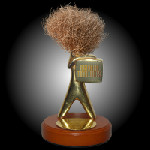Australian Tumbleweeds
Australian Tumbleweed Awards 2011 – Best Comedy
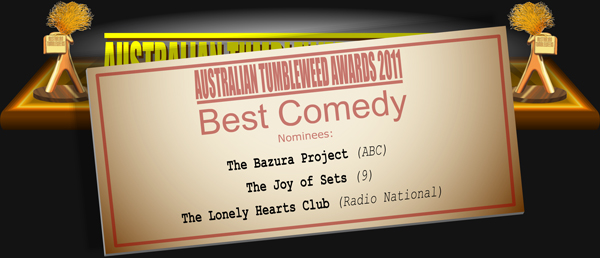 As always, the three nominees for Best Comedy have turned out to be three programs all but ignored by the Australian press. Not for them the weekly glowing reviews in the Green Guide that Laid got; no steady stream of cover features like the ones Chris Lilley enjoyed throughout the first half of the year. That’s because these three programs actually made people laugh; what kind of a hook is that to hang press coverage on? Far easier to base your value judgements on set design, or being written by a hipster, or featuring a man in a dress. Unfortunately, that does mean you end up largely ignoring comedies that are actually funny, but hey – it’s clearly a price the Australian media is willing to pay.
As always, the three nominees for Best Comedy have turned out to be three programs all but ignored by the Australian press. Not for them the weekly glowing reviews in the Green Guide that Laid got; no steady stream of cover features like the ones Chris Lilley enjoyed throughout the first half of the year. That’s because these three programs actually made people laugh; what kind of a hook is that to hang press coverage on? Far easier to base your value judgements on set design, or being written by a hipster, or featuring a man in a dress. Unfortunately, that does mean you end up largely ignoring comedies that are actually funny, but hey – it’s clearly a price the Australian media is willing to pay.
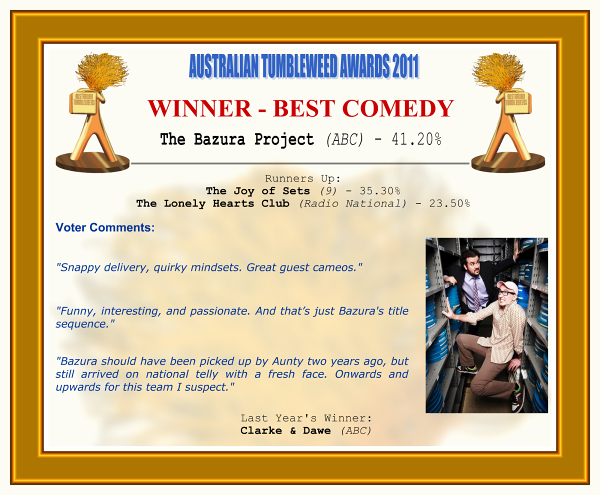 Well, this is a little embarrassing. It’s one thing for a first-time show to win Best New Comedy, but Best Comedy as well? Didn’t Tony Martin have a new television show out this year? It seems that being one of the few television comedies that put making people laugh front and centre has paid off for the Bazura team, as well it should. The Lonely Hearts Club was hilarious, but a low profile radio show was always going to struggle. The Joy of Sets quickly found its’ stride, but a wobbly start and a format that worked against Tony Martin’s natural strengths clearly put some voters offside. The Bazura Project just did everything right: funny, likeable, informative without lecturing or preaching, it turned out to be a near-perfect mix of smarts and stupidity. Whatever they’re up to next, we can’t wait to see it.
Well, this is a little embarrassing. It’s one thing for a first-time show to win Best New Comedy, but Best Comedy as well? Didn’t Tony Martin have a new television show out this year? It seems that being one of the few television comedies that put making people laugh front and centre has paid off for the Bazura team, as well it should. The Lonely Hearts Club was hilarious, but a low profile radio show was always going to struggle. The Joy of Sets quickly found its’ stride, but a wobbly start and a format that worked against Tony Martin’s natural strengths clearly put some voters offside. The Bazura Project just did everything right: funny, likeable, informative without lecturing or preaching, it turned out to be a near-perfect mix of smarts and stupidity. Whatever they’re up to next, we can’t wait to see it.
THAT CONCLUDES THIS YEAR’S PRESENTATION OF THE AUSTRALIAN TUMBLEWEEDS. KEEP FOLLOWING THIS BLOG FOR MORE COMMENTARY THROUGHOUT THE YEAR, AND DON’T FORGET TO FOLLOW US ON TWITTER OR LIKE US ON FACEBOOK.
Australian Tumbleweed Awards 2011 – Best New Comedy
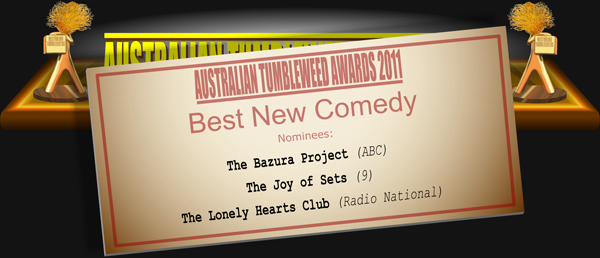 And now here we are – finally presenting some positive awards to the Australian comedy industry. This category is particularly special to our hearts, being about new talent and/or new ideas.
And now here we are – finally presenting some positive awards to the Australian comedy industry. This category is particularly special to our hearts, being about new talent and/or new ideas.
ABC-2’s The Bazura Project took a different theme each week – Violence, Sex, Money, Profanity, Drugs and Fame – and showed interestingly, and (more importantly) hilariously, how that theme had featured in and influenced more than a century of movies. Part film buff’s paradise, part sketch show, Shannon Marinko and Lee Zachariah’s “Guide to Sinema” was a detailed and – we really must stress this again – funny look at the topic. It blew similar shows by more experienced talent, such as The Joy of Sets, completely out of the water, although The Joy of Sets did feature some excellent sketches.
The Lonely Hearts Club, was an obscure but joyous late-night experiment which showed that proper radio comedy shouldn’t be forsaken in this country. In many ways it’s a great tragedy that a good show featuring some of this country’s finest comedic talent was barely promoted or acknowledged. On the other hand, it might not have worked so well if more of the callers had been aware of the joke.
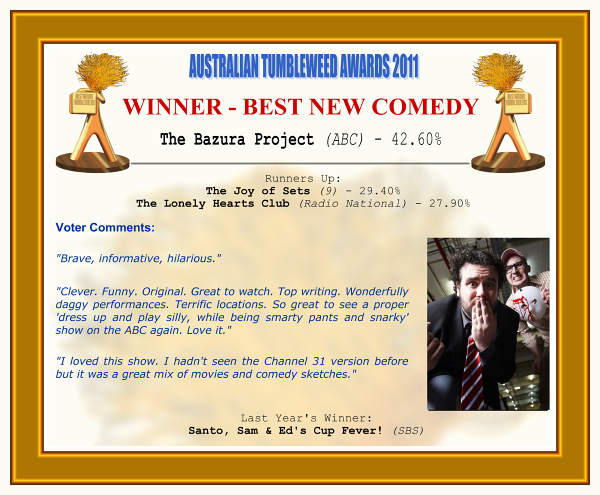 Sadly there can only be one winner of Best New Comedy, and we are pleased to announce that it is The Bazura Project. While it wasn’t technically a new show, it and the team were new to most people. It was also an outstanding example of what a passionate team can achieve with a small budget. Sharp, silly and with a consistent commitment to putting funny before everything else, it was a clear comedy highlight of 2011.
Sadly there can only be one winner of Best New Comedy, and we are pleased to announce that it is The Bazura Project. While it wasn’t technically a new show, it and the team were new to most people. It was also an outstanding example of what a passionate team can achieve with a small budget. Sharp, silly and with a consistent commitment to putting funny before everything else, it was a clear comedy highlight of 2011.
THE RESULTS OF THE NEXT CATEGORY, BEST COMEDY, WILL BE ANNOUNCED AT 8:00PM EDT.
Australian Tumbleweed Awards 2011 – The Lifetime Achievement Award for Crap Comedy
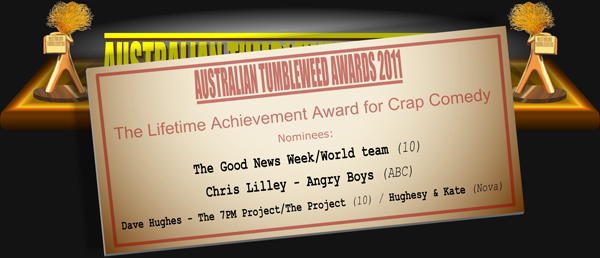 This is it – the big one. Not so much for a single year’s work at making crap comedy as a concerted effort across an entire career, this award salutes those who, year in year out, go out of their way to make comedy that puzzles, annoys, and bores the Tumblie voters. Some might say these winners are often amongst the most popular comedians of the day; we say if popularity is your only guide to quality, enjoy your steady diet of Justin Beiber music, Twilight movies, Today Tonight reports on Centerlink-Rorting Tenants from Hell in Australia’s Worst Street who can Save You Money On Your Power Bills… and, of course, the winner of this years Lifetime Achievement Award for Crap Comedy.
This is it – the big one. Not so much for a single year’s work at making crap comedy as a concerted effort across an entire career, this award salutes those who, year in year out, go out of their way to make comedy that puzzles, annoys, and bores the Tumblie voters. Some might say these winners are often amongst the most popular comedians of the day; we say if popularity is your only guide to quality, enjoy your steady diet of Justin Beiber music, Twilight movies, Today Tonight reports on Centerlink-Rorting Tenants from Hell in Australia’s Worst Street who can Save You Money On Your Power Bills… and, of course, the winner of this years Lifetime Achievement Award for Crap Comedy.
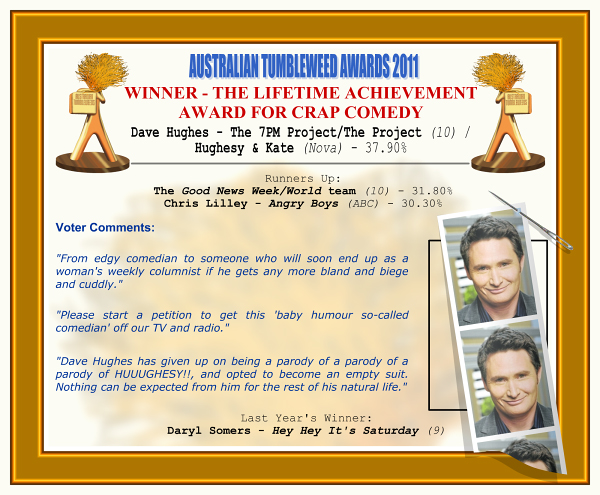 You have to take your hat off to Dave Hughes. A decade ago he was Australia’s angriest comedian, constantly losing it for laughs on youth-orientated comedy shows like Rove and The Glasshouse. Then he sat himself behind the desk at The 7PM Project and started weighing-in on the big topics of the day, and now he’s Australia’s favourite dad, keeping us all up to date with the wonders of parenthood. And yes, those wonders may seen dull and trite to everyone who either has or hasn’t gone through them, but at least he’s out there forging new ground. It’s not funny new ground or new ground to anyone but himself, but hey, let’s not start expecting miracles here.
You have to take your hat off to Dave Hughes. A decade ago he was Australia’s angriest comedian, constantly losing it for laughs on youth-orientated comedy shows like Rove and The Glasshouse. Then he sat himself behind the desk at The 7PM Project and started weighing-in on the big topics of the day, and now he’s Australia’s favourite dad, keeping us all up to date with the wonders of parenthood. And yes, those wonders may seen dull and trite to everyone who either has or hasn’t gone through them, but at least he’s out there forging new ground. It’s not funny new ground or new ground to anyone but himself, but hey, let’s not start expecting miracles here.
THE RESULTS OF THE NEXT CATEGORY, BEST NEW COMEDY, WILL BE ANNOUNCED AT 7:30PM EDT.
Australian Tumbleweed Awards 2011 – The “Pissing on Their Legacy” Award
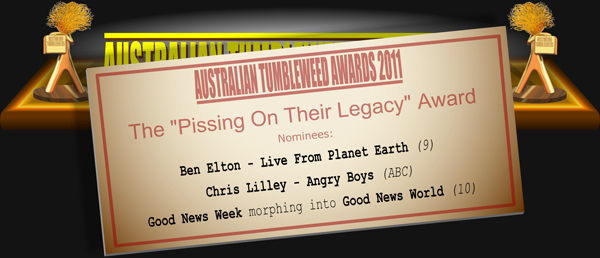 Legacies are a fragile thing in the “what have you done for me lately” world of comedy. They’re also something that should constantly be on the line as you stretch yourself trying for new and greater things. It’s when those things you’re reaching for involve a surplus of dick jokes or dressing Akmal up as various world leaders that the general public’s support tends to waver. And rightly so. Comedy should always be fresh and surprising, and we don’t mean in a “how the hell did this get 12 episodes” sort of way.
Legacies are a fragile thing in the “what have you done for me lately” world of comedy. They’re also something that should constantly be on the line as you stretch yourself trying for new and greater things. It’s when those things you’re reaching for involve a surplus of dick jokes or dressing Akmal up as various world leaders that the general public’s support tends to waver. And rightly so. Comedy should always be fresh and surprising, and we don’t mean in a “how the hell did this get 12 episodes” sort of way.
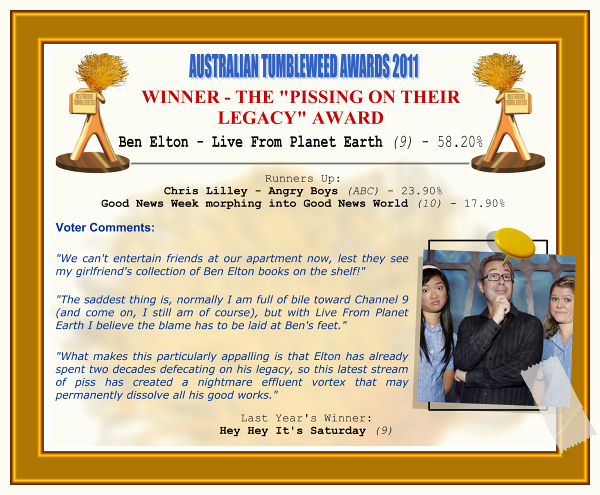 Unlike the other nominees in this category, Ben Elton had a considerable legacy to piss on. And that’s still true even if you’ve been following his sinking comedy fortunes in the UK for the last decade or so. Ben Elton was and remains a noteworthy stand-up, he is responsible for co-writing a number of excellent TV comedies, and some of his novels aren’t bad either. Unfortunately he also has a passion for pop music and stage musicals, and it is thanks to his recent involvement in those worlds that we saw such failings in Live From Planet Earth.
Unlike the other nominees in this category, Ben Elton had a considerable legacy to piss on. And that’s still true even if you’ve been following his sinking comedy fortunes in the UK for the last decade or so. Ben Elton was and remains a noteworthy stand-up, he is responsible for co-writing a number of excellent TV comedies, and some of his novels aren’t bad either. Unfortunately he also has a passion for pop music and stage musicals, and it is thanks to his recent involvement in those worlds that we saw such failings in Live From Planet Earth.
Schlocky song and dance numbers, lame gags and broad characters may be acceptable in We Will Rock You, which Elton co-wrote and directed, but it hasn’t gone down too well on TV since Elton’s boyhood and the last hoorah of TV variety. Elton gave numerous interviews responding to the criticism directed at Live From Planet Earth and he maintained that he was happy with the material he’d written. That’s probably what Chris Lilley and the Good News World team would have said too if they’d ever been called out for their shoddy work. And if that’s not an argument for decent script editors in this country then we don’t know what is.
THE RESULTS OF THE NEXT CATEGORY, THE LIFETIME ACHIEVEMENT AWARD FOR CRAP COMEDY, WILL BE ANNOUNCED AT 7:00PM EDT.
Australian Tumbleweed Awards 2011 – The “What Happened To That?!” Award for Comedies Which Failed to Appear
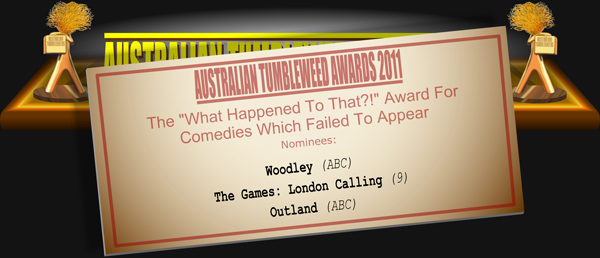 Looking over the TV listings this year, the one thought that repeatedly came to our minds is “please Australian networks, hold back on the quality shows for a while, we can barely cope with the ones we’ve already got”. And somehow they heard us, so while classics like The Renovators, and the one about cooking ,and the other one about cooking, and the third one about cooking ran for week after week after week, the occasional comedy series that actually sounded like something we’d like to see was quietly pushed back to the grim meathook future of 2012.
Looking over the TV listings this year, the one thought that repeatedly came to our minds is “please Australian networks, hold back on the quality shows for a while, we can barely cope with the ones we’ve already got”. And somehow they heard us, so while classics like The Renovators, and the one about cooking ,and the other one about cooking, and the third one about cooking ran for week after week after week, the occasional comedy series that actually sounded like something we’d like to see was quietly pushed back to the grim meathook future of 2012.
 Okay, the one comedy series we really did want to see (the ABC assures us the other two nominees will screening in February) was pushed back to “yeah, nah, we’re not going to be making that one, thanks”. Exactly why remains a minor mystery, though we’re willing to blame everything on Nine right up until the moment John Clarke and Ross Stevenson come out and say “we had a lot of trouble coming up with ideas”. Which, considering Clarke’s been talking up doing a sequel since at least the 2008 Olympics, seems a little unlikely. Let’s not forget the classy way Nine treated most of their 2011 comedy output either: if The Games: London Calling actually had happened, an 11pm timeslot by week four would have been firmly on the cards.
Okay, the one comedy series we really did want to see (the ABC assures us the other two nominees will screening in February) was pushed back to “yeah, nah, we’re not going to be making that one, thanks”. Exactly why remains a minor mystery, though we’re willing to blame everything on Nine right up until the moment John Clarke and Ross Stevenson come out and say “we had a lot of trouble coming up with ideas”. Which, considering Clarke’s been talking up doing a sequel since at least the 2008 Olympics, seems a little unlikely. Let’s not forget the classy way Nine treated most of their 2011 comedy output either: if The Games: London Calling actually had happened, an 11pm timeslot by week four would have been firmly on the cards.
THE RESULTS OF THE NEXT CATEGORY, THE “PISSING ON THEIR LEGACY” AWARD, WILL BE ANNOUNCED AT 6:30PM EDT.
Australian Tumbleweed Awards 2011 – Most Deservedly Axed or Shunted-Round-The-Schedules Program
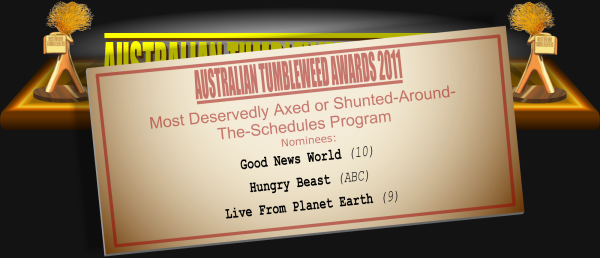 Sometimes a show’s just gotta go. Live From Planet Earth and Good News World were instant failures and their respective axings weren’t much of a surprise, even if the latter’s took a long time coming. Hungry Beast on the other hand managed to last three series, which is pretty good for a show of its type and quality. Those involved were really lucky to have been chosen for it, making their howls of protest when the show was axed seem more than a little disingenuous.
Sometimes a show’s just gotta go. Live From Planet Earth and Good News World were instant failures and their respective axings weren’t much of a surprise, even if the latter’s took a long time coming. Hungry Beast on the other hand managed to last three series, which is pretty good for a show of its type and quality. Those involved were really lucky to have been chosen for it, making their howls of protest when the show was axed seem more than a little disingenuous.
The result of this category, however, is far from disingenuous. More a sledgehammer-obvious statement of 100% dissatisfaction.
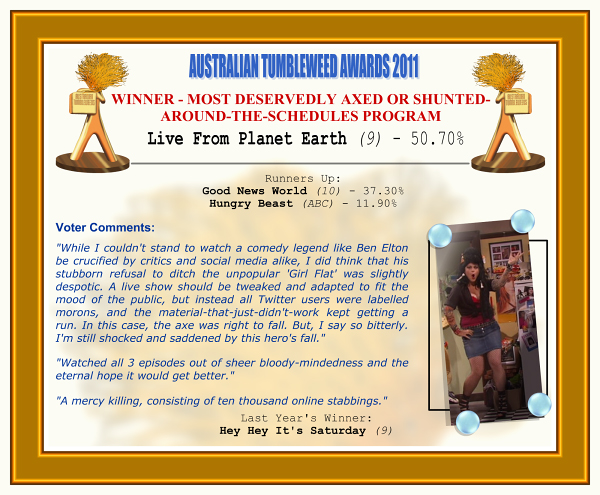 Live From Planet Earth isn’t exactly a surprise winner in this category – its name will be a byword for comedic failure for decades to come – but it’s debatable that it was more deserving of the chop than Good News World. Good News World was an equally poor program which also got slaughtered on social media, it just happened to stay on air because it was on a lower-profile network who currently have a policy of sticking rigidly by any new show…until it’s obvious even to them that they totally messed-up.
Live From Planet Earth isn’t exactly a surprise winner in this category – its name will be a byword for comedic failure for decades to come – but it’s debatable that it was more deserving of the chop than Good News World. Good News World was an equally poor program which also got slaughtered on social media, it just happened to stay on air because it was on a lower-profile network who currently have a policy of sticking rigidly by any new show…until it’s obvious even to them that they totally messed-up.
THE RESULTS OF THE NEXT CATEGORY, THE “WHAT HAPPENED TO THAT?!” AWARD FOR COMEDIES WHICH FAILED TO APPEAR, WILL BE ANNOUNCED AT 6:00PM EDT.
Australian Tumbleweed Awards 2011 – Most Irritating or Pointless Cameo / Guest Appearance
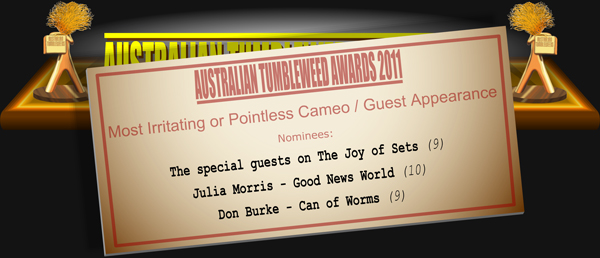 A special guest appearance from a well-known face should be a show highlight. Unfortunately special guests these days seem to be there purely to earn some easy coin or revive their careers. Don Burke’s appearance on Can of Worms had all the hallmarks of someone attempting the latter – you could tell by his swearing and attempts to shock. Julia Morris has much the same tactic when she’s a guest, except she’s less about swearing and more about being a gabbling loud-mouth.
A special guest appearance from a well-known face should be a show highlight. Unfortunately special guests these days seem to be there purely to earn some easy coin or revive their careers. Don Burke’s appearance on Can of Worms had all the hallmarks of someone attempting the latter – you could tell by his swearing and attempts to shock. Julia Morris has much the same tactic when she’s a guest, except she’s less about swearing and more about being a gabbling loud-mouth.
Mistakenly, The Joy of Sets gave over a third of its airtime to a special guest. This should have been a showstopper, sadly it just stopped the show. Dead. Instead of hilarious behind the scenes insights from an industry figurehead we got Deborah Hutton talking about…oh, we forget. Even Pete Smith with his decades of TV experience and noted wit didn’t manage to shine. Those who went to the recordings say they were great and that the guests made the show. Which for us begs this question: what happened in the edit?
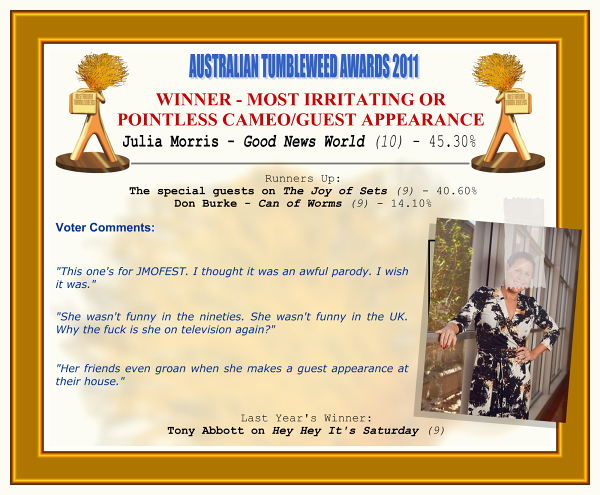 Julia Morris turning up anywhere – even that short film festival / self-promotion carnival she runs – is irritating and/or pointless, but to be irritating and/or pointless in comparison to Good News World? That’s a far more impressive achievement than her victory on The Celebrity Apprentice.
Julia Morris turning up anywhere – even that short film festival / self-promotion carnival she runs – is irritating and/or pointless, but to be irritating and/or pointless in comparison to Good News World? That’s a far more impressive achievement than her victory on The Celebrity Apprentice.
THE RESULTS OF THE NEXT CATEGORY, MOST DESERVEDLY AXED OR SHUNTED-AROUND-THE-SCHEDULES PROGRAMME, WILL BE ANNOUNCED AT 5:30PM EDT.
Australian Tumbleweed Awards 2011 – Worst Themed Comedy
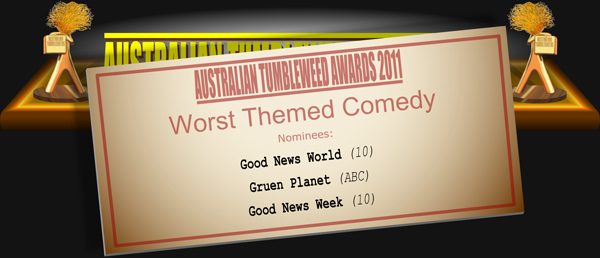 Australian comedy has a hard enough time getting laughs when absolutely anything is fair game: why would you purposely limit the targets you’re swinging at? Which is why, on even the briefest of examinations, it’s clear that while all three shows in this category claim to have firm targets in sight, they always just end up cracking jokes about anything they feel like. And good on them for it. If they’d just get around to cracking funny jokes, they might have something worthwhile to offer.
Australian comedy has a hard enough time getting laughs when absolutely anything is fair game: why would you purposely limit the targets you’re swinging at? Which is why, on even the briefest of examinations, it’s clear that while all three shows in this category claim to have firm targets in sight, they always just end up cracking jokes about anything they feel like. And good on them for it. If they’d just get around to cracking funny jokes, they might have something worthwhile to offer.
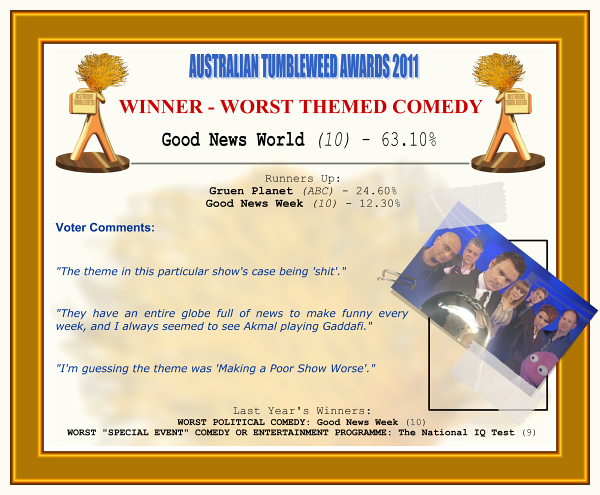 Paul McDermott is a great comedy host. He’s charming, he’s expansive, he’s got a great singing voice. He’s not someone who comes off all that well when he has to share the spotlight though, so one of the many, many mystifying choices that came from turning the stale Good News Week into the failed Good News World was to have him conduct bogus interviews and appear in sketches. And then there were all the other mystifying choices which would take at least three thousand worlds to list here so let’s just boil them down to “give Sammy J & Randy their own show and fire everyone else out of a cannon”.
Paul McDermott is a great comedy host. He’s charming, he’s expansive, he’s got a great singing voice. He’s not someone who comes off all that well when he has to share the spotlight though, so one of the many, many mystifying choices that came from turning the stale Good News Week into the failed Good News World was to have him conduct bogus interviews and appear in sketches. And then there were all the other mystifying choices which would take at least three thousand worlds to list here so let’s just boil them down to “give Sammy J & Randy their own show and fire everyone else out of a cannon”.
THE RESULTS OF THE NEXT CATEGORY, MOST IRRITATING OR POINTLESS CAMEO/GUEST APPEARANCE, WILL BE ANNOUNCED AT 5:00PM EDT.
Australian Tumbleweed Awards 2011 – Worst Coverage of Comedy
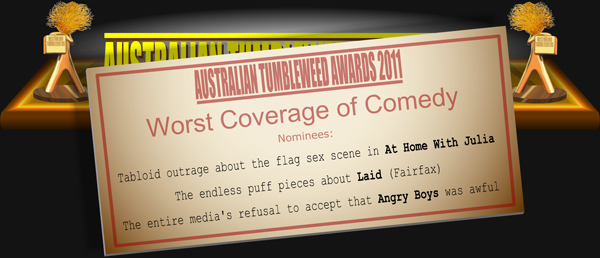 Ah, for the good old days, when the Australian media would desperately latch onto the slightest whiff of controversy about a show or comedian and never let go until someone was sacked or taken off air for a few weeks. These days even Marieke Hardy having to cough up $13,000 for “outing” the wrong man for being responsible for a disgusting hate blog barely rates a mention. Of course, the Fairfax press couldn’t say enough good things about her or her series Laid, so maybe that’s a bad example. But if the Murdoch press couldn’t find it in their hearts to seriously rally the troops around a comedy where a fake PM had fake sex on a real Australian flag, the sun had clearly set on the days when the Chaser were (metaphorically) spitting on sick kiddies with every sketch.
Ah, for the good old days, when the Australian media would desperately latch onto the slightest whiff of controversy about a show or comedian and never let go until someone was sacked or taken off air for a few weeks. These days even Marieke Hardy having to cough up $13,000 for “outing” the wrong man for being responsible for a disgusting hate blog barely rates a mention. Of course, the Fairfax press couldn’t say enough good things about her or her series Laid, so maybe that’s a bad example. But if the Murdoch press couldn’t find it in their hearts to seriously rally the troops around a comedy where a fake PM had fake sex on a real Australian flag, the sun had clearly set on the days when the Chaser were (metaphorically) spitting on sick kiddies with every sketch.
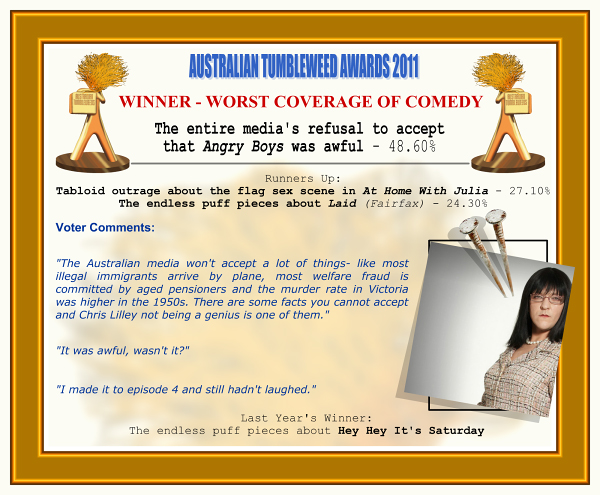 To be fair, there were a few reports on the ratings slide for Angry Boys, but for the most part the media had so firmly jumped the gun with their praise of Chris Lilley (remember that story in The Monthly calling him a genius? How about the one in The Age calling him a genius?) before Angry Boys aired they couldn’t point out the fact it was a flop without looking like they didn’t know what they were talking about. It’s interesting to note that while the claims that Lilley is a genius are still loud and strong, the example now used to back that claim up is the older (but ratings-winning) Summer Heights High. Man, there must be a lot of commentators out there praying that Angry Boys turns out to be a blip in Lilley’s career and he re-connects with audiences when his next series arrives in 2018.
To be fair, there were a few reports on the ratings slide for Angry Boys, but for the most part the media had so firmly jumped the gun with their praise of Chris Lilley (remember that story in The Monthly calling him a genius? How about the one in The Age calling him a genius?) before Angry Boys aired they couldn’t point out the fact it was a flop without looking like they didn’t know what they were talking about. It’s interesting to note that while the claims that Lilley is a genius are still loud and strong, the example now used to back that claim up is the older (but ratings-winning) Summer Heights High. Man, there must be a lot of commentators out there praying that Angry Boys turns out to be a blip in Lilley’s career and he re-connects with audiences when his next series arrives in 2018.
THE RESULTS OF THE NEXT CATEGORY, WORST THEMED COMEDY, WILL BE ANNOUNCED AT 4:30PM EDT.
Australian Tumbleweed Awards 2011 – Worst Non-Broadcast Comedy or Comedy Product
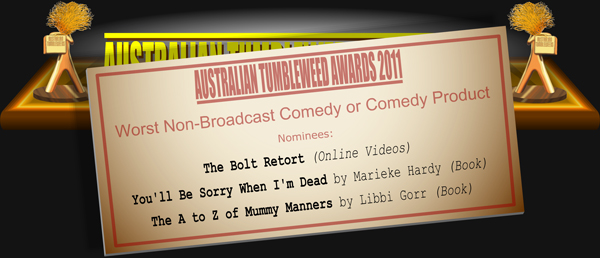 Last time we checked, The Bolt Retort’s most viewed clip on YouTube had 1,623 views. The second most viewed clip? 206 views. So presumably not only did those 1,400 people not go back for a second look, they all came over here to vote for a (in our opinion, pretty funny) five minute show by Shannon from The Bazura Project pointing out inaccuracies in Andrew Bolt’s show The Bolt Report. Hey, we just report the winners, we don’t pick ‘em.
Last time we checked, The Bolt Retort’s most viewed clip on YouTube had 1,623 views. The second most viewed clip? 206 views. So presumably not only did those 1,400 people not go back for a second look, they all came over here to vote for a (in our opinion, pretty funny) five minute show by Shannon from The Bazura Project pointing out inaccuracies in Andrew Bolt’s show The Bolt Report. Hey, we just report the winners, we don’t pick ‘em.
Remember that time Libbi Gorr had Mark “Chopper” Read on her ABC talk show? We do. Oddly, we couldn’t find any mention of that in The A to Z of Mummy Manners, her twee guide to making friends with the parents of children your children are friends with. Seriously, why bother? Most parents we know just want someone to look after their brats for a few hours, not a freakin’ soul-mate.
Marieke Hardy makes a living by talking about herself. At the heart of everything she says and does in the public eye is the conviction that it’s interesting because she’s the one doing it. Maybe she’s right? 50,000 twitter followers can’t be all wrong. Or even all actual people.
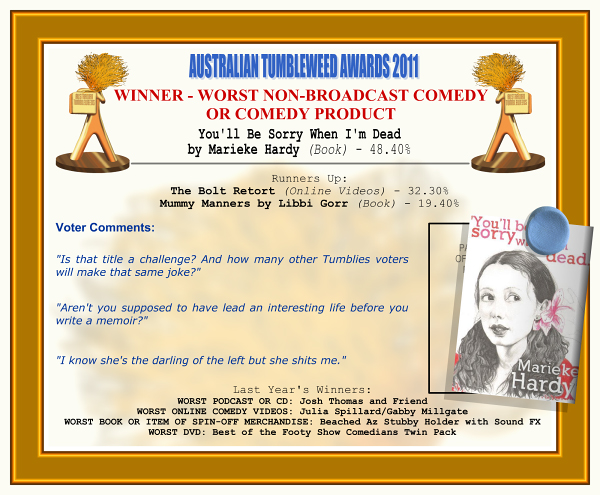 The continuing rise of Marieke Hardy is no doubt a delight for both Ms Hardy and the large number of people who wish they were her. For those trapped in an outdated way of looking at books, newspaper columns and television – as something providing the public with more than just the author’s efforts at self-promotion – it’s all a bit of a puzzle. Writing a book about your various mildly salacious relationship escapades (group sex, hiring prostitutes, etc), putting a picture of yourself on the cover, then inviting those you’ve written about to comment suggests levels of self-absorption barely sustainable by people who’ve actually achieved something with their lives. And we’re talking here about someone whose greatest achievements to date involve reviewing books on television and flashing their breasts.
The continuing rise of Marieke Hardy is no doubt a delight for both Ms Hardy and the large number of people who wish they were her. For those trapped in an outdated way of looking at books, newspaper columns and television – as something providing the public with more than just the author’s efforts at self-promotion – it’s all a bit of a puzzle. Writing a book about your various mildly salacious relationship escapades (group sex, hiring prostitutes, etc), putting a picture of yourself on the cover, then inviting those you’ve written about to comment suggests levels of self-absorption barely sustainable by people who’ve actually achieved something with their lives. And we’re talking here about someone whose greatest achievements to date involve reviewing books on television and flashing their breasts.
THE RESULTS OF THE NEXT CATEGORY, WORST COVERAGE OF COMEDY, WILL BE ANNOUNCED AT 4:00PM EDT.
